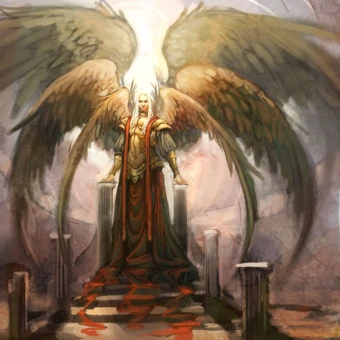(Created page with "thumb|340px'''Lucifer''' Is the well known as The Lightbringer and The First of The Fallen and is sometimes the angelic name of Satan. =='''Satan Origin'...") |
No edit summary |
||
| Line 1: | Line 1: | ||
| − | [[File:Lucifer.jpg|thumb|340px]] |
+ | [[File:Lucifer.jpg|thumb|340px]] |
| + | '''Lucifer''' Is the well known as The Lightbringer and The First of The Fallen and is sometimes the angelic name of Satan. |
||
=='''Satan Origin'''== |
=='''Satan Origin'''== |
||
Revision as of 19:08, 18 January 2018

Lucifer Is the well known as The Lightbringer and The First of The Fallen and is sometimes the angelic name of Satan.
Satan Origin
Lucifer, the Morning Star, which means light-bearer. He was a Seraphim (angel) in heaven. Eventually, he grew prideful and jealous of God's power and attempted to overthrow him, gathering up legions of followers and revolting against God. He was defeated by Michael the Archangel and cast into Hell as punishment. It is said that on the Day Of Judgment Satan shall rise to power again and lead another war against Heaven, this time he and his followers will be cast down by God himself and sent to a lake of burning fire (Hell) as an eternal punishment for their many sins.
Luciferianism
Although sometimes mistakenly associated with Satanism due to the Christian interpretation of the fallen angel, Luciferianism is a wholly different and unrelated belief system and does not revere the Devil figure or most characteristics typically affixed to Satan. Rather, Lucifer in this context is seen as one of many Morning Star, a symbol of enlightenment, independence and human progression, and is often used interchangeably with similar figures from a range of ancient beliefs, such as the Greek titan Prometheus or the Jewish figure Lilith.
Theistic Luciferianism
Some Luciferians believe in Lucifer as an actual deity, not to be worshipped as the Judeo-Christian God but to be revered and followed as a teacher and friend, as a rescuer or guiding spirit, or even the one true god as opposed to the traditional creator of Judaism. Theistic Luciferians are followers of the Left-Hand Path and may adhere to different dogmata put forth by organizations such as the Neo-Luciferian Church or other congregations that are heavily focused on ceremonial magic, the occult and literal interpretations of spiritual stories and figures.
Historical Luciferianism
The Gesta Treverorum records that, in 1231, heretics began to be persecuted throughout Germany. Among them were Luciferians, principally in the Archdiocese of Trier, but also Mainz and Cologne. Over the following three years, several people were burned as a result. According to a papal letter from Gregory IX, Vox in Rama, dated from July 13, 1233, one of the claims made by the Luciferians was that Lucifer had been cast out of Heaven unjustly.
On the other hand, Richard Cavendish has argued: "The confessions Conrad of Marburg extracted were apparently made without torture, but under the threat of death if the victim did not confess. If these confessions were accurate, the Luciferans were full-blown Satanists. They worshiped the Devil as creator and ruler of the world, complained that he had been unjustly and treacherously banished from Heaven, and believed that he would overthrow the God of the Christians and return to Heaven, when they would enjoy eternal happiness with him. They reveled in whatever displeased the Christian God and hated whatever pleased him..."